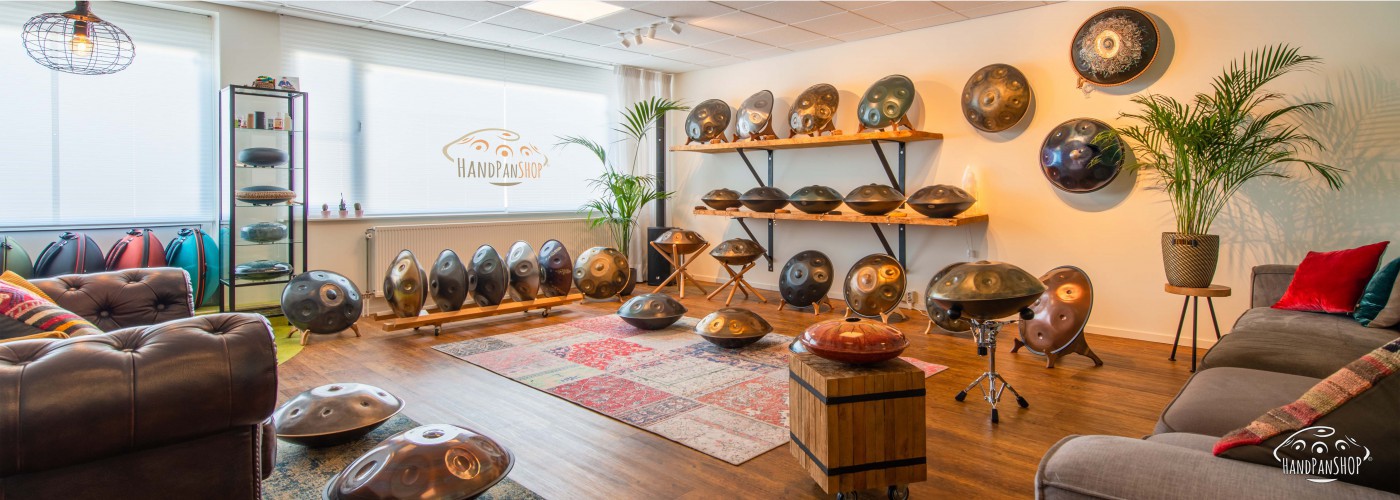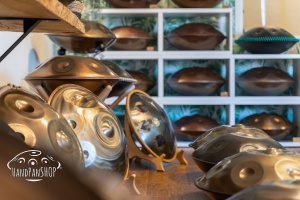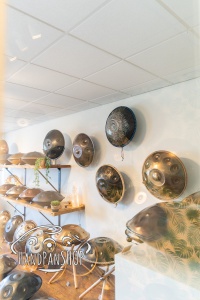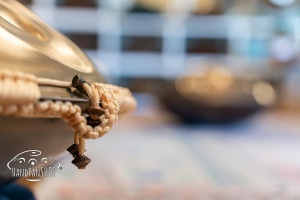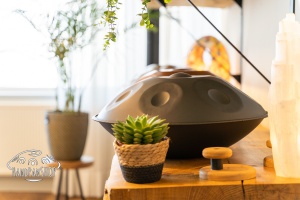Choosing the Right Handpan Scale
Finding the right handpan can be quite a challenge. Nowadays, there are numerous variations to choose from – different builders, materials, and on top of that, the question of which scale you prefer. We understand that it might be difficult to make a decision. That's why we have developed orientation sessions. In these 90 minutes sessions, you will be guided in a calm and relaxed manner in order to find the perfect handpan, that suits you the best. All materials and scales from a wide range of different builders will be presented.
Before attending an orientation session, it might be helpful to gather more knowledge. Which scales can you can choose and how will the different scales influence your sound? On this page, we'll outline the major differences between a wide selection of scales.
Handpan scale minor
Handpan scale minor; Kurd/Annaziska
Firstly, the most well-known and popular scale. When people talk about handpans, they usually refer to the minor scale. Minor is the most neutral scale, allowing you to easily guide your sound towards melancholic and heavy, or cheerful and playful. Kurd and Annaziska are the most neutral variations within the minor scales. The note sequence is identical to the minor scale you would play on a piano or guitar, with no notes being skipped.
Kurd or Annaziska?
These are two names for the same scale. It might sound confusing, and it actually is. To make things more complex, the name "Aeolian" is also sometimes used.
Aeolian is a handpan term that is somewhat fading away. Aeolian is synonymous with minor. As you will read later in this blog, there are multiple minor variations with different names. So, using one of these names (or a synonym) to refer to all of them is not practical. It might have been sufficient in the early years of handpans, but nowadays more specificity is required.
Kurd is the most commonly used term. This name is used for most minor scales. For example, you may come across A Kurd, B Kurd, D Kurd, and E Kurd. The exceptions are C and C#. Different names are used for these scales.
Annaziska is an alternative name. The note sequence is identical, but when it comes to C and C#, they are called Annaziska, not Kurd. Sometimes you might see some variation. For instance, you might encounter a D Annaziska or a C# Kurd, but as a general rule, it's the opposite: C and C# are called Annaziska, and everything else is called Kurd.
Handpan scale minor: Celtic Minor/Amara
Again, two names that are being used for the same scale. Celtic Minor/Amara, like Kurd/Annaziska, is a minor scale. The difference lies in the note sequence: while Kurd/Annaziska strictly follows the minor scale without skipping any notes, Celtic Minor/Amara skips one note and adds an extra high note in its place. In practice, this means that Celtic Minor/Amara has one low note less, but one high note more than Kurd/Annaziska.
By skipping that low note, the scale becomes very clear and easy to play. For intuitive, free playing, a Celtic Minor/Amara handpan is somewhat easier to handle than a Kurd/Annaziska. There are more notes that fit well together, and all the suitable notes are conveniently placed.
Regarding the two names, the same explanation as for Kurd/Annaziska is applicable. Celtic Minor is used for everything except C and C#. So, you might come across an A-, B-, D-, or E Celtic Minor, but not a C or C# Celtic Minor.
Amara is used for C and C#. Again, the terms are sometimes used interchangeably. You might come across a B Amara, but in general, it's restricted to only C and C#.
Handpan scale African/minor: Pygmy
Pygmy scales are becoming increasingly popular. You see these scales more and more, and in various variations. The Pygmy scale is based on an African minor scale. Like Celtic Minor/Amara, some notes are skipped in Pygmy scales, resulting in a broader range and a specific character. By omitting certain notes or emphasizing others, a certain atmosphere is created. Pygmy has a beautiful open sound. It sounds more adventurous and less ordinary than other minor scales, which makes it stand out.
Pygmy and Low Pygmy
Pygmy comes in two variations: Pygmy and Low Pygmy. The scale is identical for both, but the difference lies in the starting point: Low Pygmy begins and ends at a lower point. However, a Low Pygmy is not necessarily lower in pitch than a regular Pygmy. If the fundamental note is lower, a Pygmy can still sound lower. For example, an A3 Pygmy may have more low notes than an E3 Low Pygmy, simply because the starting point is lower (A3 instead of E3).
Handpan scale minor: Mystic
Mystic is the lesser-known scale among the minor scales. It is similar to Celtic Minor/Amara, but with a few differences. Again, one note is skipped in the sequence, which results in a broader range. The difference lies in the note that is skipped: in Celtic Minor/Amara, the sixth note of the scale is omitted, while in Mystic, it's the seventh note. This gives Mystic a dreamier and more dramatic character compared to Celtic Minor/Amara.
Mystic is sometimes also used as a collective term. If it doesn't fit within other specific names, it might be called Mystic. So, you might come across different types of scales that have not much in common but are all called Mystic.
Handpan scale major
Everything mentioned above was about minor scales. Minor is by far the most common scale for handpans, roughly three-quarters of all handpans are made in a minor scale. The reason for this is simple, minor is the most neutral scale. While neutral may be the safest choice, choosing a scale with more character or direction can also be very interesting. Handpans with a major scale have a more uplifting and cheerful character. They are not the best choice if you are looking for a melancholic atmosphere, but they are perfect if you want a bright, sunny and fresh sound. Even within major scales, there are numerous variations.
Handpan scale major: Paradiso
The most well-known major scale is Paradiso. This scale has a wide and open range, making it easy to play intuitively. It has a sunny, paradise-like atmosphere. Paradiso starts a bit lower in the scale and ends quite high. To achieve this, certain notes are omitted. This creates a similar playing style to Celtic Minor/Amara because by skipping some notes, you are left with a set of notes that fit well and easy together. This considerably reduces the chance of less harmonious note combinations, making it a pleasant scale for intuitive players.
Handpan scale major: Sabye
Another well-known major scale is Sabye. This scale is very similar to the Ashakiran scale. It has a slightly more adventurous structure than Paradiso. The starting point is different (the fourth note in the sequence instead of the third or fourth). This "unusual" starting point gives Sabye or Ashakiran a more intriguing and ethereal sound. It has a beautiful, hopeful tone with a lively character.
Handpan scale major: Aegean
Aegean is a major scale, but has characteristics that can be placed somewhat between major and minor. Paradiso, Sabye, and Ashakiran all clearly have a cheerful and sunny character. Aegean also possesses this quality but has a darker side as well. This is partly due to the lower starting point (the third note in the sequence) and partly due to a different note sequence. Aegean is a Lydian scale, which gives it a spacious, atmospheric and dreamy character.
Handpan scale oriental
When you are looking for handpans with a distinct and unique character, you can't ignore the eastern scales. These pans can be recognized immediately. When these handpans are being played during our orientation sessions, they always attract attention. They have colourful, atmospheric scales with a clear eastern character. Within the eastern character, there are still some subtle differences.
Handpan scale oriental: Saladin
Saladin is the most joyful scale within the eastern scales. It is very similar to Celtic Minor/Amara, but it has some adjustments that give it a distinctive atmosphere. It's the right scale if you want to give your sound an energetic character.
Handpan scale oriental: Hijaz
Hijaz is the largest and most well-known eastern scale. It starts a bit lower, which gives it a more layered character. Hijaz sounds deep, adventurous, and mysterious. Hijaz includes many variations, including Romanian Hijaz. These scales differ slightly from each other, but they all share this beautiful, mysterious atmosphere.
Handpan scale oriental: Harmonic Minor
Harmonic Minor is the most "Western" variant of these scales. Compared to Celtic Minor/Amara, one note has been adjusted. This single note is raised by only a half step, so the difference is minimal. However, this small difference significantly influences its character, giving it more drama and a similar eastern atmosphere as Saladin and Hijaz. Harmonic Minor is the most dramatic of these three scales and has a deep and grounded scale.
Choosing the handpan scale that suits you
In the end, you'll know what you want when you hear the instrument live. To collect extra information before you buy a handpan, can certainly help you understand what to look for and may aid you in determining what you really want. Or don’t want, for that matter. But ultimately, it's all about the connection with the instrument.
If you're unsure about what you want, now or in the future, we recommend to start with a minor scale handpan. These handpans have the most neutral atmosphere and are the most common. If you feel a strong connection to major or eastern scales, it might be a good choice as it aligns better with your character.
In reality, there are no right or wrong choices, nor specific choices for beginners or advanced players. The only choice is the right choice for you.
More information on our page Choosing the best handpan.


